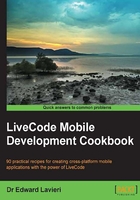
What this book covers
Chapter 1, LiveCode Mobile Basics, introduces you to the concepts and steps that are required to set up your computer to develop Android and iOS applications using LiveCode. You'll learn how to set up your development environments, what icons and images are required for the apps you create, how to use the mobile simulator, how to run your apps on physical devices, and how to get your apps into the global marketplace.
Chapter 2, Human-computer Interfaces, demonstrates a variety of human-computer interface objects and how they can be used in your mobile apps. In addition to learning about buttons, cards, input boxes, dialog windows, and geometric shapes, you'll explore password masking, card navigation, and how to change an object's properties.
Chapter 3, Loops and Timers, has you examine the LiveCode scripting required to implement and control count-up and countdown timers. You'll also learn how to use loops to count and iterate through a list.
Chapter 4, Managing Text, offers you a complete coverage of how to manage text to include reading the user input, searching, replacing, combining, encrypting, writing, reading, sorting, formatting, and appending. As a bonus example, this chapter includes the LiveCode scripting required to create the Pig Latin text.
Chapter 5, Communications, shows you how to initiate a phone call from within your mobile apps. You will also learn how to format and send an e-mail.
Chapter 6, Data Structures, explores how to use advance data structures to include arrays (both one- and multidimensional), XML, SQLite, and MySQL.
Chapter 7, External Media, covers everything you need to know about external media for your mobile apps. You'll learn how to load an external image, how to capture an image from a mobile device's camera, how to resize an image, and how to play movie and audio clips.
Chapter 8, Using MobGUI, provides an introduction to using the MobGUI LiveCode plugin to accelerate your mobile app development. This chapter provides hands-on recipes using all of MobGUI's interface objects.
Chapter 9, Using Animation Engine, presents 10 recipes that explore the power of the Animation Engine plugin's capabilities. You'll learn how to move objects, stop objects, change the speed of objects, simulate gravity, and more.
Chapter 10, Miscellaneous, introduces you to LiveCode's mathematical computation abilities. In addition to gaining hands-on experience with math operations, you'll learn how to open and query a web page, how to use the geometry manager, how to use invisible objects, how to detect the user's mobile operating system, and how to take snapshots of cards and specific areas on a card.